Discovering the local flora and fauna of a state is exciting. Native trees provide a variety of benefits to wildlife, birds, and insects and add beauty and diversity to your garden. This blog post will discuss the different types of trees native to Texas and how they can benefit wildlife, birds, and insects.
What Trees are Native to Texas?
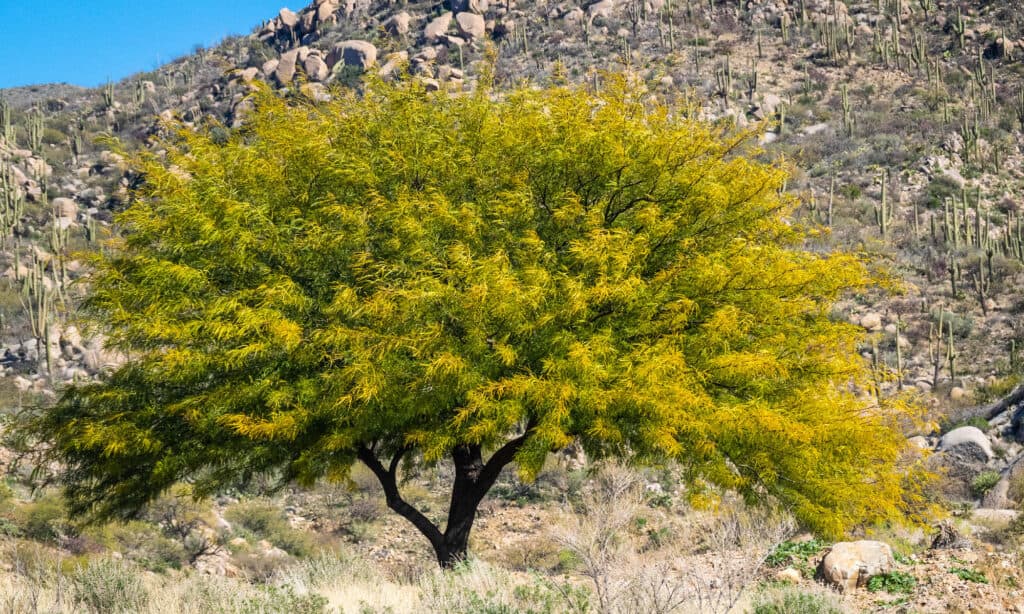
©Eugenie Robitaille/Shutterstock.com
Texas is home to nearly 300 native tree species. Each tree species provides different benefits to wildlife, birds, and insects. For example, sweet acacia delivers nectar for honeybees and butterflies, while black cherry offers food for deer and other animals. Red buckeye attracts hummingbirds, while blue beech provides food for caterpillars.
Depending on the region of Texas, different trees are more common in the area. In some parts of Texas, such as the east and southeast regions, you can find loblolly pine, longleaf pine, and shortleaf pine trees. Other areas in the state include red oak and post oak which thrive in central Texas.
The south-central part of Texas is home to bald cypress and pecan tree varieties. Northcentral areas have a variety of elm trees, while western regions boast juniper trees with their distinct foliage. Along coastal plains, you will find palmettos along with sabal palms, which provide a unique landscape for those living near beaches or riversides. And desert climates support mesquite trees adapted to dry conditions.
No matter where you live in Texas, there is sure to be a native tree species to add beauty and charm to your environment! Here are some of our favorites.
1. Sweet Acacia
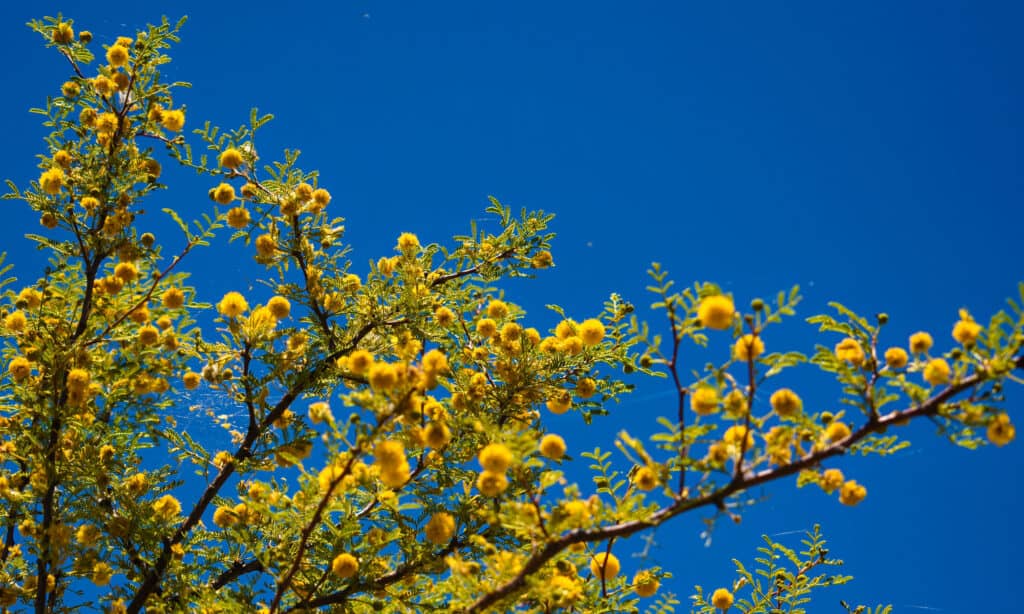
©Nyka Erickson/Shutterstock.com
Sweet Acacia (Acacia farnesiana) is a native tree of Texas that can grow up to 15-30 feet in height and spread out 20 feet across. Its leaves are bright green and bipinnate with numerous small leaflets. The fragrant yellow flowers bloom from February through May, and the trees produce an abundance of seed pods that remain on the branches throughout much of the year.
This species is drought tolerant and prefers full sun exposure in well-draining soils. It has a moderate growth rate but will require occasional pruning to maintain desired shape or size. Sweet acacias make attractive shade trees for larger landscapes and provide food sources for wildlife such as birds and butterflies. Deer and peccaries love to eat its fruit.
2. Green Ash
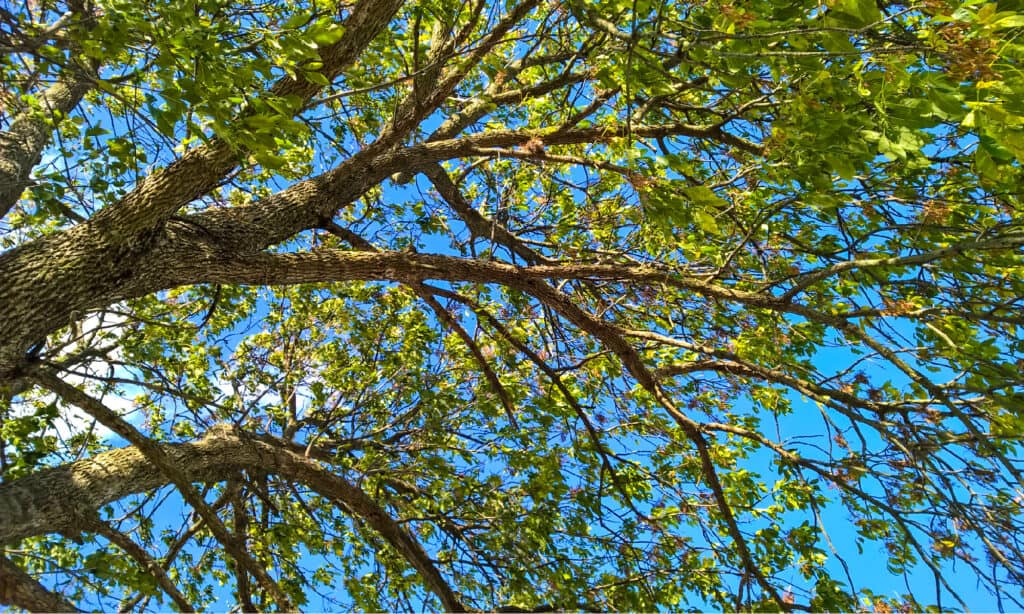
©iStock.com/Ethan R.
Green Ash (Fraxinus pennsylvanica) is a deciduous tree native to eastern Texas. It is one of the most common ash species in North America. You can find it growing in moist areas such as near streams, lakes, or ponds. Its bark is grayish-brown with shallow furrows that become more pronounced with age. The leaves are compound and have seven to nine leaflets per leaf with pointed teeth along the edges. Green ash typically produces flowers from April to June, which form clusters at the tips of branches; these flowers are inconspicuous and greenish-white in color.
As its name implies, green ash bears bright green fruits during late summer or early fall. These fruits contain seeds that birds love to eat. The seeds that don’t get eaten mature into their characteristic papery wings. This species makes an excellent shade tree due to its dense canopy of foliage. As the leaves fall into ponds and puddles, they are one of the main food sources for growing tadpoles.
3. Blue Beech

©Gerry Bishop/Shutterstock.com
Blue beech (Carpinus caroliniana), also known as American hornbeam, is a tree native to eastern Texas and much of the east United States. It can grow up to 50 feet tall with a trunk of one or two feet thick. The bark is smooth and grayish-green, while the leaves are deciduous and have sawtooth edges. Blue beech prefers moist, shady areas like stream banks or wet woods but can tolerate some drought once established.
Its small seeds are popular with birds such as chickadees, titmice, woodpeckers, and nuthatches, who feed on them during winter. Several species of butterflies depend on blue beech trees when they are in the caterpillar stage.
4. Rusty Black Haw
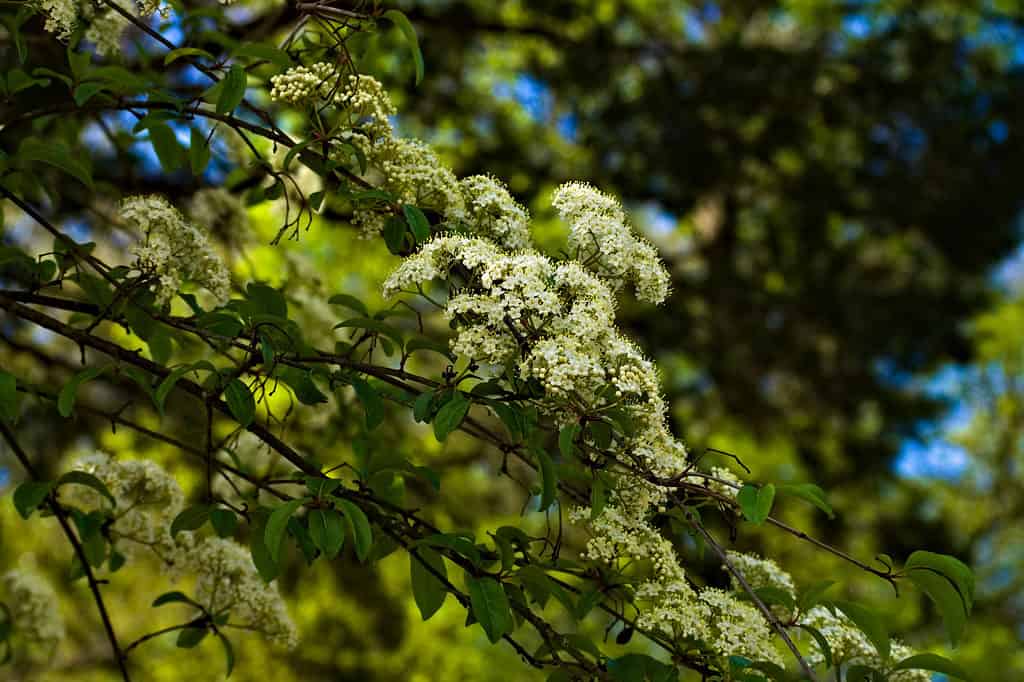
©Xianghong Garrison/Shutterstock.com
The rusty black haw (Viburnum rufidulum) is an evergreen shrub or small tree native to Texas. It grows in dry areas at low elevations. This slow-growing plant can reach heights of up to 10 feet with a spread of 5 feet or more. The glossy green leaves are oval-shaped and have wavy edges that turn reddish-purple in the fall before dropping off for winter. The bark looks very similar to flowering dogwood and ranges in color from red to dark red.
Its flowers appear as creamy white clusters during late spring, followed by dark blue berries that attract birds throughout the summer months. The rusty black haw is also known for its hardiness and drought tolerance, making it a great choice for people who want a low-maintenance addition to their landscape design!
5. Red Buckeye
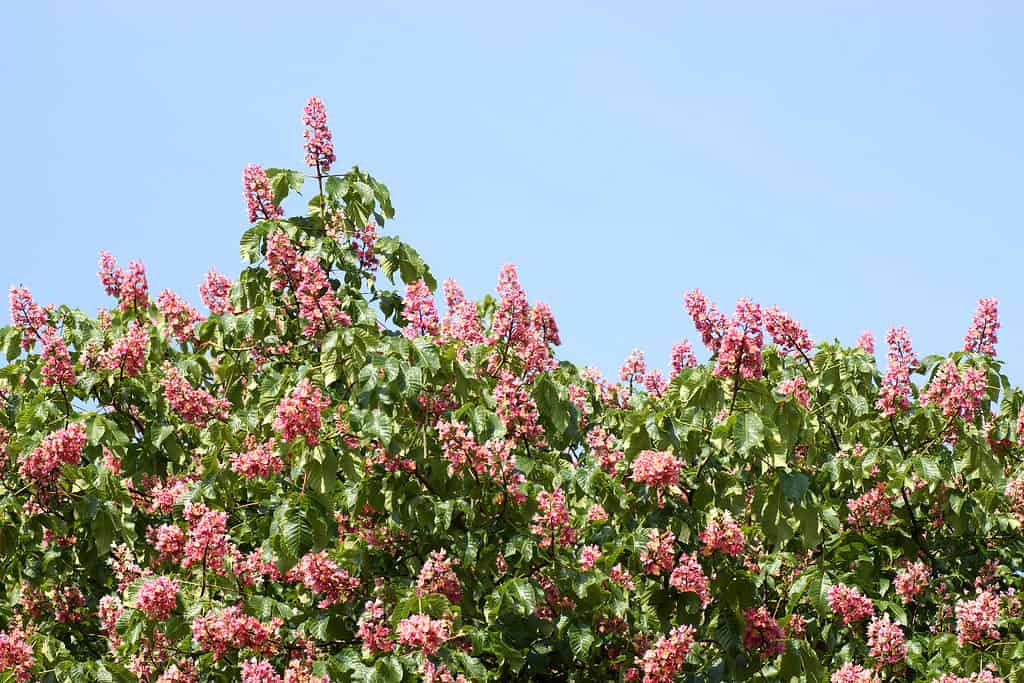
©Bildagentur Zoonar GmbH/Shutterstock.com
Red buckeye (Aesculus pavia) is a deciduous tree native to Texas and the southeastern United States. Red buckeye trees grow up to 25 feet tall and produce clusters of red-orange tubular flowers atop their branches in the springtime. The leaves are opposite, with five leaflets that turn yellow in fall before they drop off for winter.
This species has great ornamental value due to its colorful display of blooms during the flowering season and attractive foliage throughout most of the year. Hummingbirds and bees love the nectar inside the lovely red flowers.
6. Chapote
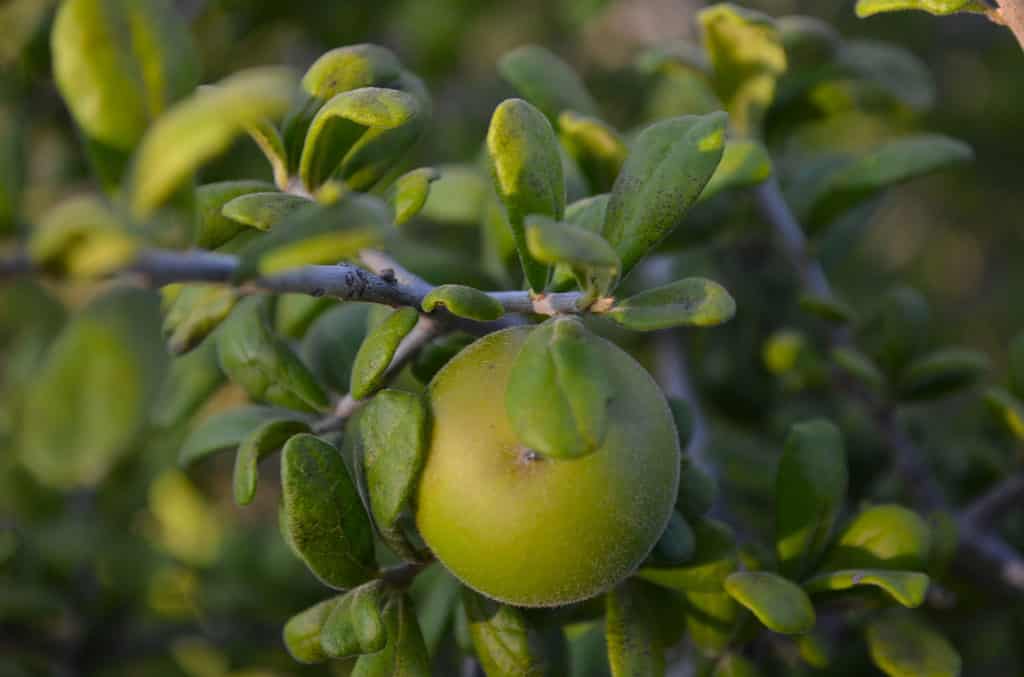
©Renee Foskett/Shutterstock.com
The chapote tree, also known by its scientific name Diospyros texana and persimmon, is native to Texas and can be found in the southern parts of the state. This tree grows 10-35 feet tall and lives for around 50 years. The leaves are dark green, with a smooth texture on top and a fuzzy underside. The bark is smooth and reddish gray and starts peeling as it matures. It prefers alkaline, well-draining soil.
Its small yellow flowers appear in March or April, followed by edible fruit that ripens in August. The chapote tree is a host plant for the grey hairstreak and Henry’s elfin butterflies in the caterpillar stage.
7. Black Cherry

©iStock.com/TeleMakro Fotografie (Ina Hensel)
The black cherry (Prunus serotina) is a medium-sized deciduous tree native to Texas. It can grow up to heights of 80 feet with a trunk diameter of two feet or more and has an open, spreading crown. The bark is smooth and thin when the tree is young but dark gray, nearly black as it ages.
The flowers are small white clusters that bloom in springtime, followed by small round berries which ripen from green to red in late summer or early fall. These cherries have sweet flesh but contain pits like other cherry varieties. Birds and bears love the fruits, and many animals help disperse the seeds around the forest, helping them spread.
8. Texas Cedar Elm
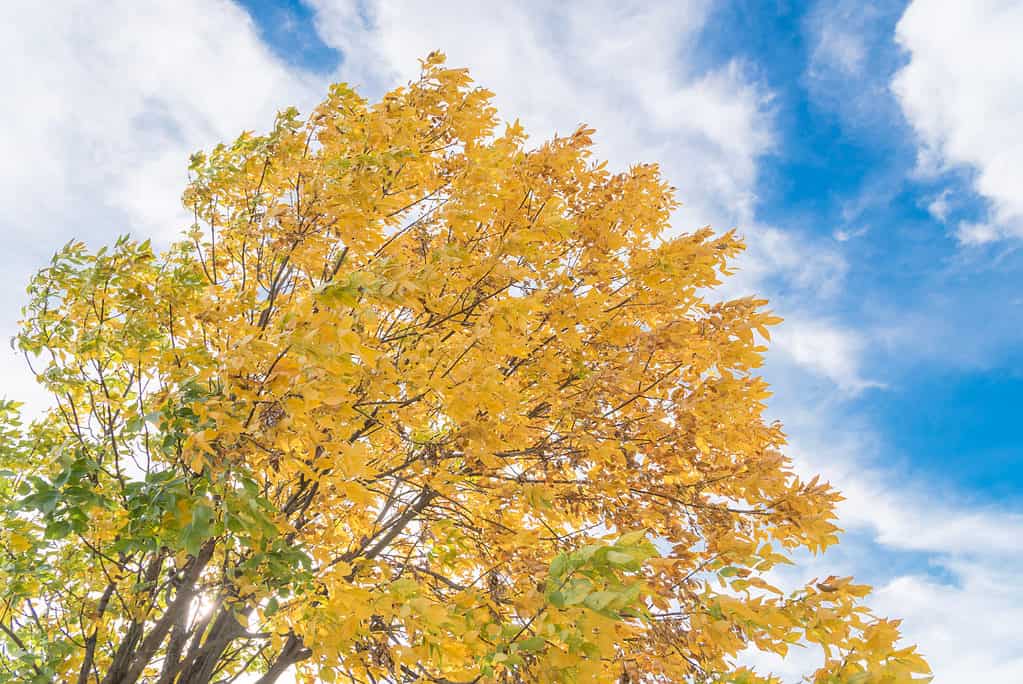
©Trong Nguyen/Shutterstock.com
The cedar elm (Ulmus crassifolia) is a deciduous tree native to Texas and other parts of the southern United States. It typically grows to be around 75-85 feet tall with a tall rounded crown. The fragrant flowers bloom in late summer and are a lovely reddish-purple color. The fruit is a small, winged samara that matures in late fall.
The cedar elm is an excellent choice for providing shade due to its large canopy, but it also provides great habitat for many animals, such as birds, squirrels, deer, and raccoons. It is relatively drought tolerant once established, making it a great option for those living in dry climates or areas with low water availability during certain times of the year.
9. Bigtooth Maple

©iStock.com/mdesigner125
Bigtooth maple (Acer grandidentatum) is native to central Texas. It is a small or medium-sized deciduous tree that can grow 50 feet high. It has lovely dark brown bark with flat ridges that look like scaley plates. The leaves are bright yellow and red in autumn.
In spring, yellow-green flowers appear, followed by fruit. The fruit is a samara made up of two winged seeds joined at the base. It is first green, then red, and then brown when fully mature. This tree is loved as a nesting and roosting site for many birds and small mammals. Squirrels and chipmunks love to eat the seeds and store the extras for winter.
10. Southern Live Oak

©iStock.com/Sunshower Shots
Southern live oak (Quercus virginiana) is native to Texas and found in a large portion of the state. It’s known for its durable wood, which can withstand harsh weather conditions and be used for various purposes. Its leaves are dark green on top with grayish-green undersides, giving it an overall silvery color when viewed from a distance. The southern live oak has a deep taproot that anchors it well against windy, stormy conditions. It produces green catkin-like flowers and acorns about one inch in diameter.
This stately oak tree is not only beautiful but also a primary home and food source for many wild animals, birds, and insects. Bobwhite quail, squirrels, white-tailed deer, scrub jays, wood ducks, yellow-bellied sapsuckers, wild turkeys, and black bears all depend on the acorns for food. The dense canopy is a cozy nesting site for many mammals.
What is the State Tree of Texas?
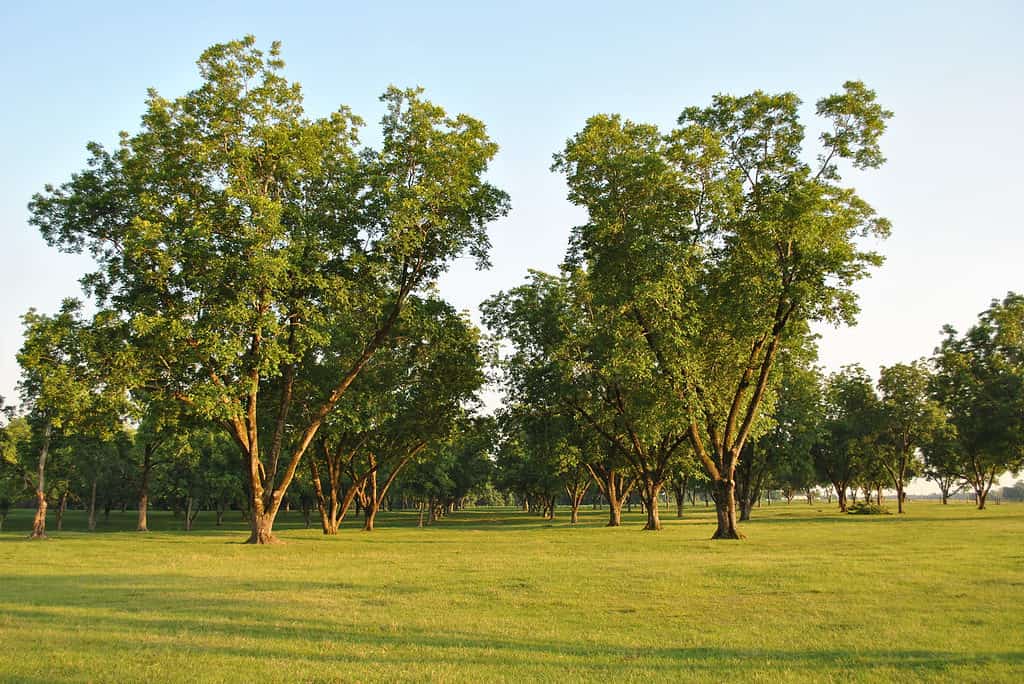
©Tayloradempsey/Shutterstock.com
The pecan tree has been the state tree of Texas since 1919, making it an integral part of both the economy and ecology in the Lone Star State. Texas loves pecans so much that they made pecan pie the state pie in 2013!
Pecan trees are incredibly important to Texas’ agricultural industry, as they are used for their nuts which can be harvested and sold on the market. Texas produces around 30-50 million pecans per year.
Additionally, these trees provide homes for a wide variety of wildlife, such as birds and squirrels. Pecan trees also help maintain healthy ecosystems by providing shade, reducing soil erosion, and improving water quality with their root systems. These majestic trees have a lifespan of over 200 years and are beloved symbols in many parts of Texas!
Are Mesquite Trees Native to Texas?
Mesquite trees are a leguminous type of tree that is native to Texas. They grow in many parts of the state, with honey mesquite (Prosopis glandulosa glandulosa) being the most widespread variety. Mesquite trees are drought-tolerant and provide many benefits for wildlife, birds, and insects.
The seedpods and leaves from the mesquite tree provide food for quail, deer, collared peccaries, coyotes, cactus mice, and jackrabbits. The flowers attract bees, butterflies, and hummingbirds. The leaves of the tree provide shade for small animals, while the branches offer nesting sites for birds.
Are Fruit Trees Native to Texas?
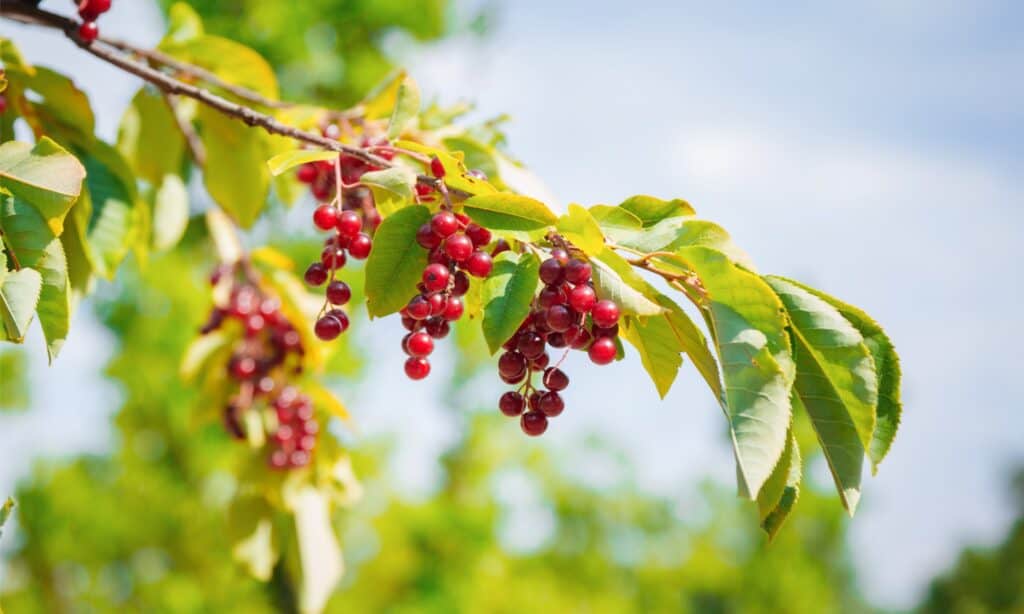
©iStock.com/Elenakirey
Fruit trees are beneficial for providing food for humans and wildlife, birds, and insects. There are a variety of fruit trees native to Texas, including pecan (Carya illinoinensis), pawpaw (Asimina triloba), persimmon (Diospyrus virginiana), and flatwoods plum (Prunus umbellata). You can also find Mexican plum trees (Prunus mexicana), black cherries (Prunus serotina), chokecherries (Prunus virginiana), and southern crabapples (Malus angustifolia) in Texas.
Each of these trees provides a variety of benefits for wildlife, birds, and insects. For example, the flowers attract pollinators, the leaves feed caterpillars, the seeds are foraged by squirrels, and the fruits sustain many different animals, like bears and turkeys.
Are Palm Trees Native to Texas?
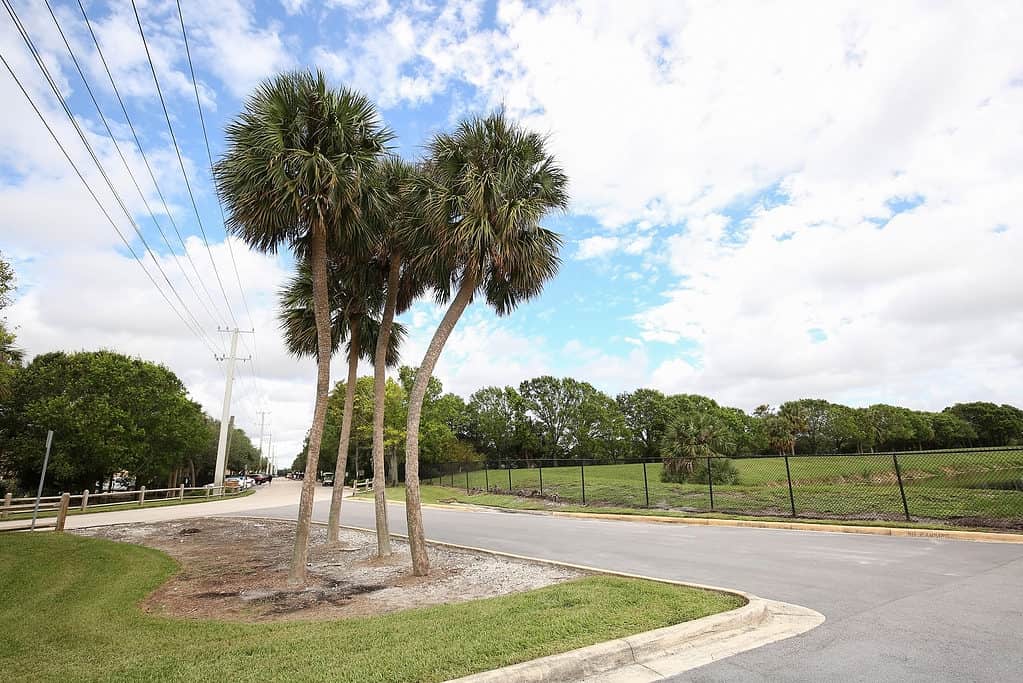
©iStock.com/JillianCain
Palm trees are not only beautiful but also provide a variety of benefits for wildlife, birds, and insects. Some palm trees native to Texas include cabbage palm (Sabal palmetto), dwarf palm (Sabal minor), and Texas palmetto (Sabal mexicana).
These trees produce abundant fruits that feed bears, deer, squirrels, raccoons, bobwhite, and wild turkey. They are also favorite snacks for crows, mockingbirds, woodpeckers, robins, and warblers.
Conclusion
Native trees are an important part of any garden or landscape in Texas. Not only do they add beauty and diversity, but they also provide a whole host of benefits for wildlife, birds, and insects. Many wonderful trees are native to Texas. You can help create a habitat that benefits local wildlife by planting these trees in your garden or landscape.
Summary of 10 Beautiful Trees Native to Texas
- Sweet Acacia
- Green Ash
- Blue Beech
- Rusty Blackhaw
- Red Buckeye
- Chapote
- Black Cherry
- Texas Cedar Elm
- Bigtooth Maple
- Southern Live Oak
UP NEXT…
- 12 Incredible Trees Native to Maryland
- 15 Beautiful Trees Native to Louisiana
- Are there Bears in Texas?
The post 10 Beautiful Trees Native to Texas appeared first on AZ Animals.
from Animal News, Facts, Rankings, and More! - AZ Animals https://ift.tt/9iNs7Mv